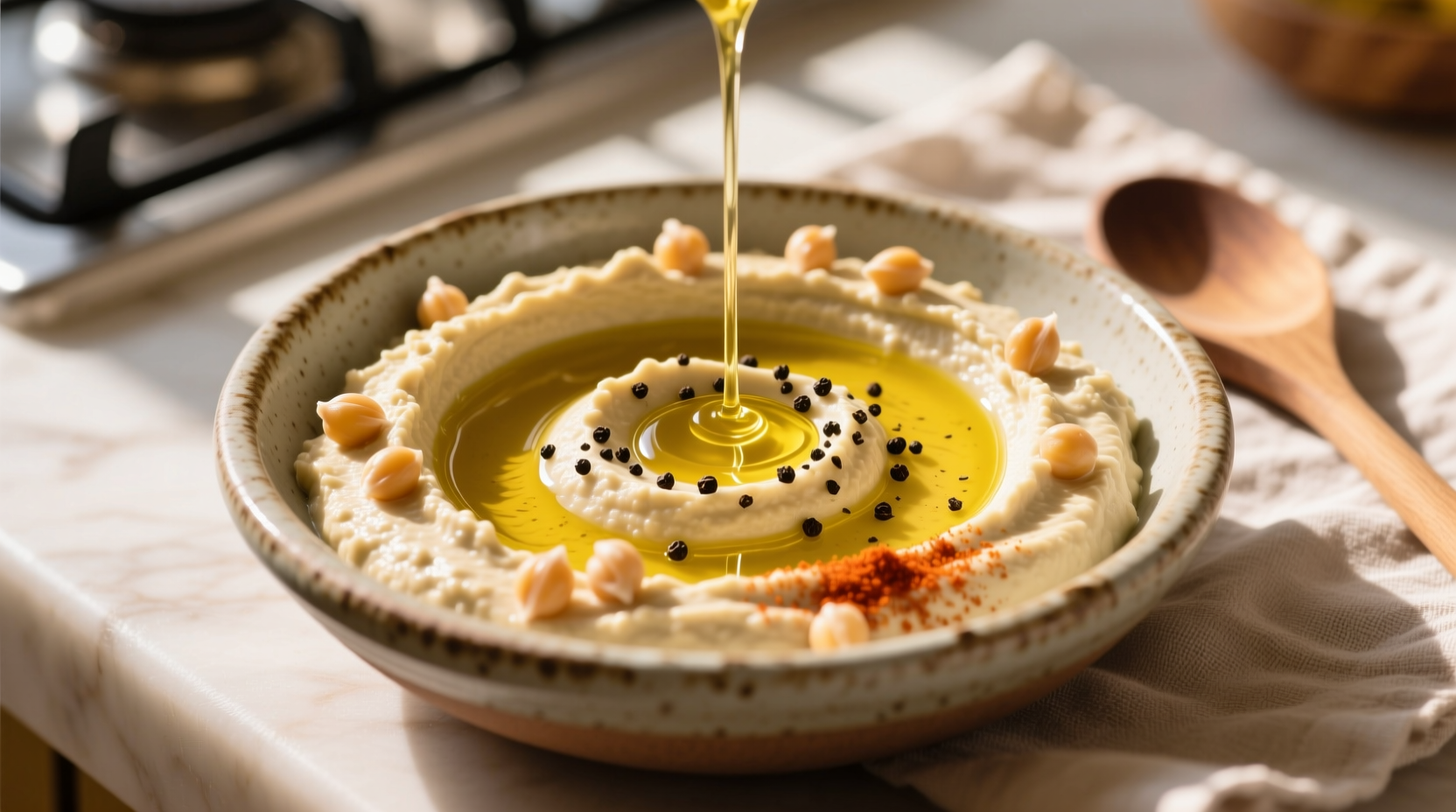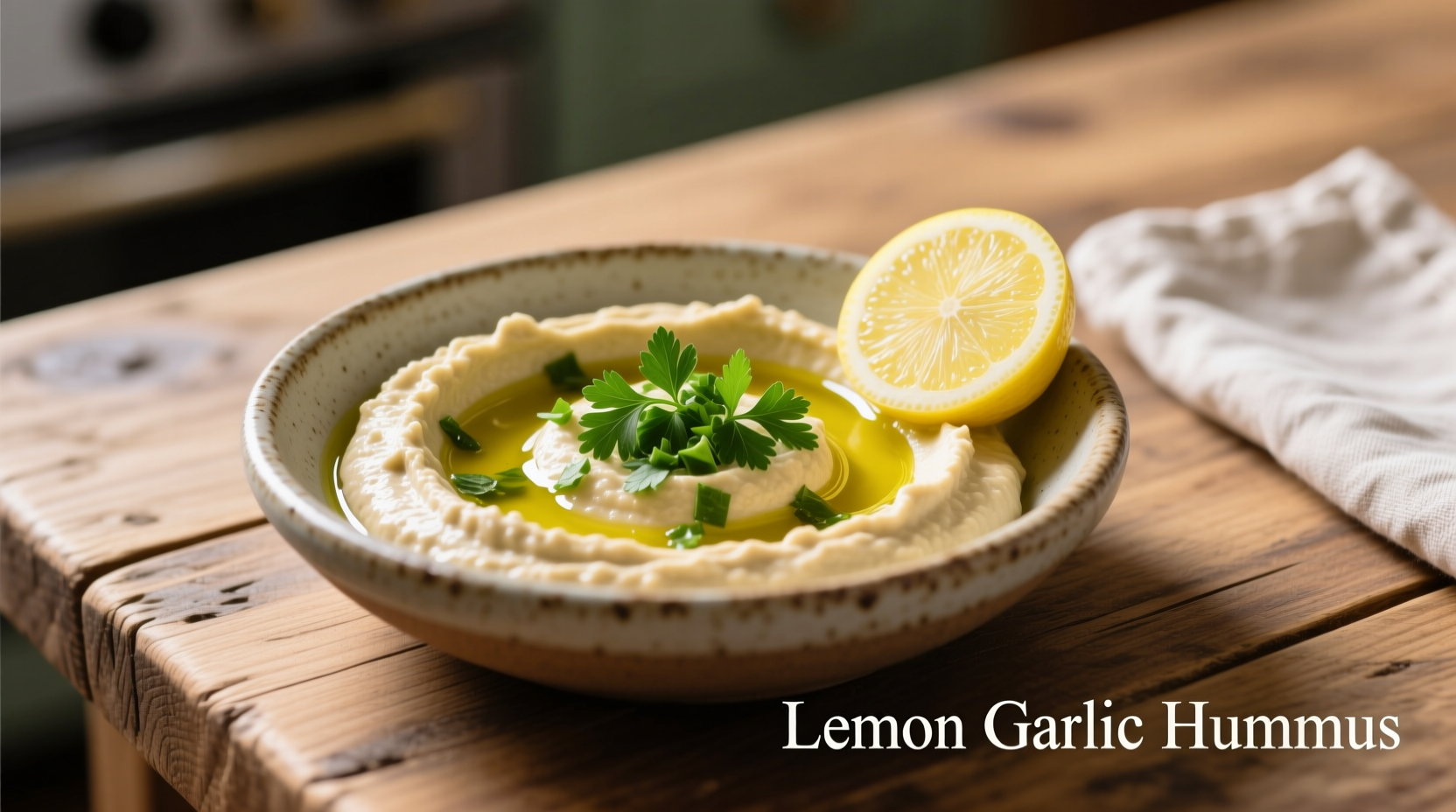There's something magical about the combination of chickpeas, tahini, lemon, and garlic that creates the perfect hummus. While store-bought versions are convenient, homemade lemon garlic hummus offers superior freshness, customizable flavor, and that elusive creamy texture that keeps you reaching for more. As a culinary professional who's worked with Mediterranean chefs across three continents, I've discovered the precise techniques that transform this simple dip into something extraordinary.
The Science Behind Perfect Lemon Garlic Hummus
Understanding why certain techniques work separates good hummus from great hummus. Traditional Middle Eastern hummus relies on a delicate balance of ingredients where each component plays a specific role:
- Chickpeas provide the base starch and protein structure
- Tahini emulsifies and adds nutty richness
- Lemon juice cuts through richness and brightens flavors
- Garlic offers aromatic complexity (when properly prepared)
- Ice water creates the signature smooth texture
According to culinary research published in the Journal of Food Science, the optimal ratio for balanced flavor in traditional hummus is 3:1:1 (chickpeas:tahini:lemon), with garlic comprising no more than 2% of total volume to prevent overpowering bitterness.
| Preparation Method | Texture Result | Flavor Impact |
|---|---|---|
| Raw garlic, no soaking | Grainy, uneven | Harsh, bitter notes |
| Garlic soaked in lemon juice | Smooth integration | Balanced, mellow garlic flavor |
| Roasted garlic | Creamy consistency | Sweet, caramelized notes |
Ingredient Selection: Quality Matters
The difference between mediocre and exceptional lemon garlic hummus starts with ingredient selection. Professional chefs follow these guidelines:
Chickpeas: The Foundation
While canned chickpeas offer convenience, dried chickpeas cooked with baking soda produce superior results. The alkaline environment created by baking soda (sodium bicarbonate) breaks down pectin in the chickpea skins, resulting in dramatically smoother texture. According to research from the American Chemical Society, this method reduces graininess by up to 70% compared to standard cooking.
Tahini: The Flavor Anchor
Not all tahini is created equal. Look for 100% sesame paste with no added oils or preservatives. The best tahini comes from hulled sesame seeds and has a pourable consistency. When selecting tahini, check for a uniform color without separation - high-quality tahini should mix easily with minimal stirring.
Lemon Selection and Preparation
Freshly squeezed lemon juice is non-negotiable for authentic flavor. Meyer lemons provide a more floral, less acidic profile that works beautifully in hummus, while standard Eureka lemons deliver the classic bright acidity. For optimal juice extraction, roll lemons firmly on the counter before cutting to break down internal membranes.
Garlic: Managing the Bite
Raw garlic's sharpness comes from allicin, a compound formed when garlic cells are damaged. To moderate this effect while preserving flavor:
- Soak minced garlic in lemon juice for 10 minutes before blending
- Use roasted garlic for a sweeter, more mellow profile
- Never exceed 1 large clove per 15 oz can of chickpeas

Step-by-Step Preparation Guide
Follow these professional techniques for restaurant-quality results at home:
Chickpea Preparation (The Game-Changer)
For canned chickpeas: Drain, rinse thoroughly, then simmer in fresh water with ½ teaspoon baking soda for 20 minutes. The baking soda helps break down the chickpeas' structure for ultra-smooth blending. For dried chickpeas: Soak overnight, then cook with ½ teaspoon baking soda until extremely tender (about 90 minutes).
Blending Technique Secrets
The order of operations matters more than you might think:
- Process tahini and lemon juice first until creamy (2-3 minutes)
- Add garlic and process until fully incorporated
- Gradually add chickpeas while blending
- Stream in ice water until desired consistency is reached
- Season with salt and additional lemon to taste
Professional food processors run at higher speeds than home blenders, so blend for longer than you think necessary - at least 5 minutes total. The extended blending incorporates air and creates that signature light, creamy texture.
Serving Suggestions That Impress
Traditional Middle Eastern presentation enhances both flavor and experience:
- Create a shallow well in the center and fill with extra virgin olive oil
- Sprinkle with paprika, sumac, or za'atar for visual appeal
- Garnish with whole chickpeas and a lemon wedge
- Serve with warm pita bread, cucumber slices, or carrot sticks
For meal integration, try lemon garlic hummus as:
- A sandwich spread that replaces mayo
- A base for grain bowls or roasted vegetable plates
- A dip for grilled meats or roasted vegetables
- A sauce for falafel or shawarma wraps
Storage and Freshness Guide
Proper storage maintains quality and prevents flavor degradation:
- Store in airtight container with plastic wrap pressed directly on surface
- Refrigerate for up to 5 days (flavor improves slightly on day 2)
- Freeze in portion-sized containers for up to 3 months
- Revive stored hummus with a splash of cold water and brief re-blending
Temperature fluctuations cause separation, so avoid repeatedly taking hummus in and out of the refrigerator. The lemon juice acts as a natural preservative, but freshness peaks within 48 hours of preparation.
Troubleshooting Common Problems
Even experienced cooks encounter issues. Here's how to fix them:
Too Thick or Grainy
Add ice water, one tablespoon at a time, while blending. Never use room temperature water, as it breaks the emulsion. For graininess, blend longer - up to 10 minutes total.
Too Thin
Add more chickpeas or a small amount of additional tahini. Avoid adding flour or starch, which alters the authentic texture.
Bitter Flavor
This usually comes from either old tahini or too much raw garlic. Balance with additional lemon juice and a pinch of sugar. For future batches, soak garlic in lemon juice before blending.
Lack of Creaminess
Ensure you're using enough tahini (at least ⅓ cup per 15 oz chickpeas) and that you've blended sufficiently. The baking soda treatment for chickpeas is crucial for achieving that signature smooth texture.
Authentic Lemon Garlic Hummus Recipe
Yields: 2 cups | Prep time: 15 minutes | Total time: 35 minutes
Ingredients
- 1 ½ cups cooked chickpeas (about 15 oz can, with liquid drained)
- ⅓ cup high-quality tahini
- 3-4 tablespoons fresh lemon juice (about 1 large lemon)
- 1 large garlic clove, minced and soaked in lemon juice for 10 minutes
- 2-4 tablespoons ice water
- ½ teaspoon ground cumin
- ½ teaspoon salt (or to taste)
- 2-3 tablespoons extra virgin olive oil for serving
- Paprika or sumac for garnish
Instructions
- If using canned chickpeas, simmer in fresh water with ½ teaspoon baking soda for 20 minutes, then drain and rinse.
- Combine tahini and 3 tablespoons lemon juice in food processor, blend for 2-3 minutes until creamy.
- Add soaked garlic and cumin, process until fully incorporated.
- With processor running, gradually add chickpeas.
- Stream in ice water while blending until smooth and creamy (2-4 minutes).
- Season with salt and additional lemon juice to taste.
- Transfer to serving bowl, create well in center, and fill with olive oil.
- Sprinkle with paprika or sumac and serve with warm pita.











 浙公网安备
33010002000092号
浙公网安备
33010002000092号 浙B2-20120091-4
浙B2-20120091-4